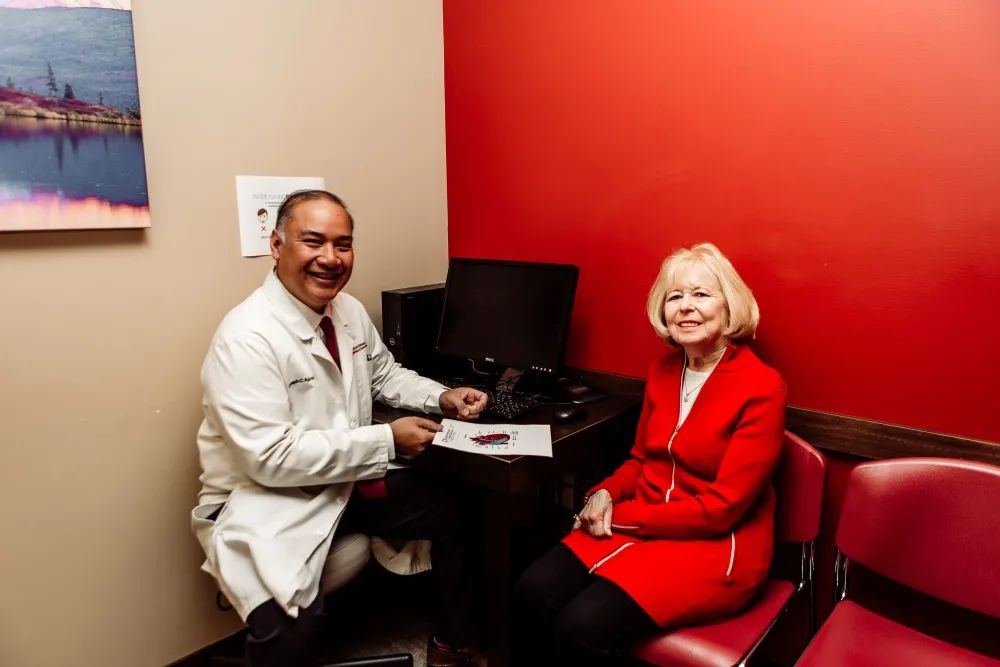
Making Strides Toward Heart Health
February 2022
by stephanie hobby
In the summer of 2006, Robin Tunnicliff just knew something was off. Only 15 minutes into her regular neighborhood walks with her husband, the avid golfer would start feeling tired and a pressure in her chest.

Robin Tunnicliff | photo by Arianna Skoog
“I dismissed it for most of the summer, thinking I was just tired, or it was maybe something I ate or drank,” she said. Strangely, the sensation didn’t strike on the golf course, but by August, she had a stark realization. Walking the course meant stopping to hit the ball and offering just enough break to reset before the remaining holes. "I got to the point of thinking, this happens pretty regularly, and I called my doctor," Tunnicliff said.
An exam by her primary care physician confirmed the need for specialized care, and she was referred to Dr. Joseph Apostol of Cardiovascular Consultants of Montana. His team wasted no time scheduling her appointment; she was in his office the following day.
A 90 percent blockage in her anterior descendent artery was behind her symptoms. Dr. Apostol determined that Tunnicliff would need a stent to open it up. As a teacher, Tunnicliff planned to have the procedure done during the October fall break, but Dr. Apostol and his team convinced her to forgo her golf tournament scheduled for later that same week to get it done. He implanted the stent on Thursday, and Tunnicliff was home by Friday and ready to teach that Monday's first day of school. "It all happened quickly, but I felt very at ease with the whole procedure. The team explained what they were going to do, and they did it,” she said.
Despite having very few risk factors and an active lifestyle, Tunnicliff had faced a serious heart issue. Unfortunately for women, it's not unusual for mild symptoms to mask more dire heart issues. For example, classic heart attack symptoms that immediately alert patients to seek care - such as excruciating pain and chest pressure - often don't manifest in women.
In Tunnicliff’s case, her symptoms didn't match what most people think heart disease looks like. "I recall thinking, 'This is just some pain and discomfort. I don’t really recall shortness of breath, not necessarily fatigue. I just remember thinking that it really probably isn’t quite normal.”
Dr. Apostol agreed. “It wasn’t obvious, like, ‘This is a massive heart attack,’ but there was concern because it affected her daily activity. She was walking regularly and recognized something wasn’t quite right,” he said. “Robin did the right thing and got concerned about her symptoms, contacted her primary care physician, and then had the follow up visit with us.”

photo by Arianna Skoog
He pointed out that even though women are just as likely to have heart disease as men, the signs can be different. For example, when women present to the emergency room, the condition can appear more vague with symptoms that include fatigue, breathing problems, and possibly pain in the jaw or between the shoulder blades. Dr. Apostol, whose mother has heart disease, said, “If there’s a sense that these symptoms may not be classic, but they may be concerning, that's something you need to act on. You can't delay in that diagnosis; you can't delay further testing and further treatment."
Heart health in Montana mirrors the rest of the country. Even though we tend to be more active, tobacco use in the Treasure State is higher than the national average. For optimal heart health, it’s a good idea to take stock of your risk factors, reduce those you can, and manage those you can’t.
Typical risk factors are:
- Diabetes
- High blood pressure
- High cholesterol
- Reduced physical activity.
- Family history and genetics
Research in the last decade has shown that family history and genetics also play a role, so those with an immediate family member experiencing heart disease, particularly under the age of 50, should talk to their physician about risks.
A helpful tool in staying on top of our heart health is a fitness tracker. A study by Stanford University researchers in the last decade showed that wearable devices led to greater patient accountability for heart health. So now, when visiting their doctors, they aren't just guessing about their physical activity and heart rates; patients can print out charts to show how they're doing.
A cascade of recent research is cause for great optimism about the future of heart disease. Dr. Apostol says one of his favorite things about his chosen field is the dynamic nature of cardiology. “Even two or three decades ago, we didn’t have advanced pacemakers or defibrillators. We didn’t have catheters that could ablate heart rhythm abnormalities, and now, within this three-decade period, we have all of it,” said Dr. Apostol, adding that we're heading into an incredibly exciting era for personalized medicine. "Hopefully, in my lifetime, instead of putting this stent into your body to open up a blockage, we’re going to administer gene therapy or monoclonal antibodies to reverse or stabilize your condition without having to go in there and physically do something to your body. It’s always innovative and changing.”
Tunnicliff has benefitted from that advancing research; in 2008, just two years after her initial treatment, Dr. Apostol placed a second, more advanced, and more effective stent inside the first to bolster its capability.
And while she faced a serious diagnosis, Dr. Apostol said she avoided complications by listening to her instincts and seeking care early. “If you address the symptoms early enough that you can prevent something catastrophic - and that’s unfortunately what we see when people come to the hospital, is that then we’re dealing with a catastrophe - if you’re just more aware and in tune with the symptoms, and get prompt care, then you can prevent a serious heart attack, and can prevent a bad outcome.”
Today, outside of regular follow-up appointments and staying aware of potential symptoms, Tunnicliff is back to normal. “I really don’t even give it a second thought. There are just these bumps in the road, and you just go on with the rest of your life. I truly don’t even ever, ever worry about it.”
GO RED FOR WOMEN
In 2004, the American Heart Association launched its annual event, Go Red for Women, to raise awareness of female heart disease. For decades, heart disease awareness had been largely thought of as a male condition, despite the fact that one in three women die of heart disease. So, for the past 18 years, Americans have donned red on the first Friday in February to help raise awareness, boost healthcare equality, and encourage women to take charge of their heart health. For more information, visit www.goredforwomen.org.
Originally printed in the February 2022 issue of Simply Local Magazine
Never miss an issue, check out SLM's digital editions here!





